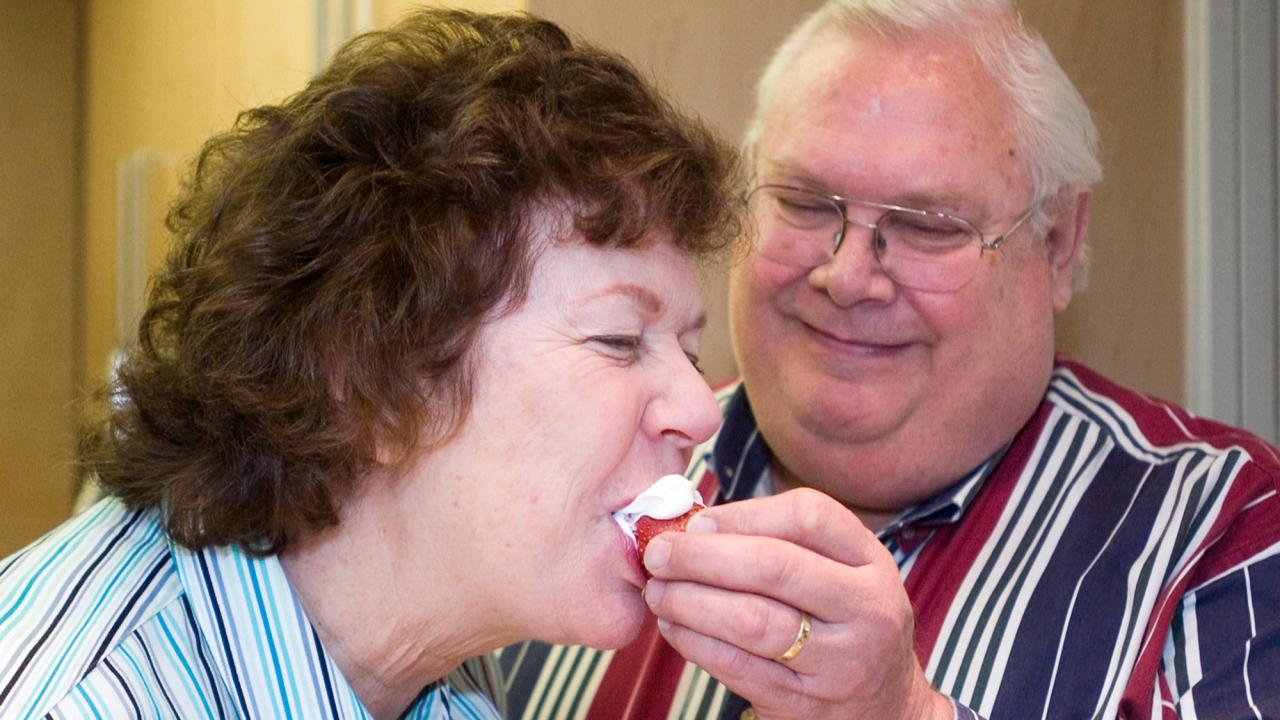There's nothing like whipped cream to go with your strawberries. Or science.
Either way, "It's fun," said John Bruhn, explaining his and his wife Christine's research on whipping cream. Both work in the Department of Food Science and Technology; he is a bacteriologist and she is director of the Center for Consumer Research.
They wanted to know how pasteurization and ultrapasteurization affect cream's whipping time — the whippability factor, so to speak.
"Even though it might be seen as trivial … compared to the much more weighty subjects we deal with, it shows how the work of the university can relate to people's everyday lives," Christine Bruhn said.
For her, those weightier subjects include food safety, nutrition, labeling and irradiation. For him, they include the safety of milk and dairy foods. The safety element includes pasteurization, which uses heat flashes to kill microbial pathogens. Cream's whippability enters into both of their fields, so the Bruhns tackled the issue together.
"We had received six or seven inquiries from consumers asking why it was taking longer to whip their cream," Bruhn said. "We figured many other people had the same question, but were not calling in."
The Bruhns' study, "Observations on the Whipping Characteristics of Cream," appeared in the Journal of Dairy Science in 1988. Nearly two decades later, the Bruhns are talking about whippability again — this time in connection with an inquiry from Long Island, N.Y., via Newsday.
"God bless them," food writer Erica Marcus said in a telephone interview, thanking the Bruhns for giving her the answer she needed for her March 8 "Burning Questions" column. A reader had complained that ultrapasteurized cream did not whip well.
To find out why, Marcus launched a Google search with terms like "dairy," "Ph.D.," "university" and "technology." Up popped John Bruhn's name.
"I felt like I had found the best people in the world to answer my question," said Marcus, who ended up talking with both Bruhns.
John Bruhn has been a dairy scientist at UC Davis since 1969 and plans to retire in June. Christine Bruhn, who also has a doctorate degree, has been director of the Center for Consumer Research since 1986.
"We both work in applied sciences," John Bruhn said, "which makes it easier for us to relate to the general public."
Indeed, he offered easy-to-understand science to describe pasteurization (using heat to kill unwanted organisms) and in Marcus' column:
"Whipping is really an aggregation of the fat globules in cream," he told her. With raw milk, the fat molecules "are just sitting nicely waiting to come together," unimpeded by the protein molecules also present. "But when you heat milk (such as by pasteurization), you alter the proteins and they attach themselves to the fat globules," making it that much harder for the fat to agglomerate. "The more severe the heat treatment, the more time it takes to whip."
Marcus noted that ultrahigh pasteurization "has gained popularity" in recent years, and the Bruhns explained the difference. In normal pasteurization, they said, dairy products are heated to about 161 degrees for at least 15 seconds. In ultrahigh pasteurization, products are heated under pressure to about 250 degrees for at least two seconds.
With ultrahigh pasteurization, the Bruhns said, a product's refrigerated shelf life could be up to four times longer — say 35 to 65 days for ultrapasteurized heavy cream, compared with 17 to 28 days for the same cream with conventional pasteurization.
But with longer shelf life comes that whipping problem!
Ultrapasteurized cream will whip just fine, John Bruhn told Marcus, but the process just takes longer.
For their 1988 study, the Bruhns figured out how much longer by experimenting in the kitchen of their Davis home. Christine Bruhn summarized the findings for Marcus' column: While pasteurized and ultrapasteurized cream "both whipped to excellent volume and held their whipping foam for comparable lengths of time," pasteurized cream usually whipped within a minute or two, while it took anywhere from 3 1/2 to five minutes to get the ultrapasteurized cream to whip. "When you're used to it whipping in a minute or less, you begin to wonder what's going on here."
For a Dateline photo session, the Bruhns re-created part of the experiment — in their own kitchen again, with the same KitchenAid mixer. And, though this experiment was highly informal, they observed that something about whipping cream had changed since 1988. Now, pasteurized and ultrapasteurized cream took about the same time to whip: from a minute and a half to two minutes or so.
"Perhaps we need to repeat out study," John Bruhn said.
He theorized that dairy processors had figured out the right combination of heat and whipping aid additives to arrive at standardized whipping times.
"That's good for the consumer," said Christine Bruhn, explaining that people expect consistency in the food they buy, even when purchases are months apart.
That is usually the case with whipping cream, which most people do not use regularly. But for those who like to have it on hand, the Bruhns said, ultrapasteurized is the way to go — because it will keep in the refrigerator for a month or more.
Perfect for those spur-of-the-moment strawberry desserts.
Media Resources
Media Contact:
- Dave Jones, editor, Dateline UC Davis, 530-752-6556 or dljones@ucdavis.edu
